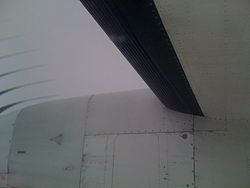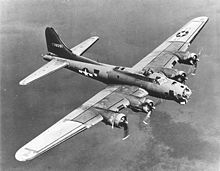- Deicing boot
-
The black rubber deicing boot on the wing of a Bombardier Dash 8 Q400 passenger aircraft is inflated with air, producing ridges to crack and dislodge any accumulated ice

A deicing boot is a type of ice protection system installed on aircraft surfaces to permit a mechanical deicing in flight. Such boots are generally installed on the leading edges of wings and control surfaces (e.g. horizontal and vertical stabilizer) as these areas are most likely to accumulate ice and any contamination could severely affect the aircraft's performance.
Contents
Design
A deicing boot consists of a thick rubber membrane that is installed over the surface. As atmospheric icing occurs and ice builds up, a pneumatic system inflates the boot with compressed air. This expansion in size cracks any ice that has accumulated, and this ice is then blown away by the airflow. The boots are then deflated to return the wing or surface to its optimal shape.
They are an older technology and have some drawbacks. Boots need to be replaced frequently (on the order of 2–3 years) and proper care for deicing boots is critical. Any holes in the boot will create air leaks that will decrease, if not eliminate, any effect that the boots may have. As such, boots must be carefully inspected before each flight and any holes or cuts must be patched.
Deicing boots have undoubtedly saved many lives and have permitted flight into known icing conditions, but they are unable to handle extremely severe icing. In these cases, ice can accumulate faster than the boots can shed it, or ice can accumulate on non-booted surfaces to the point where it disrupts airflow enough to cause a dangerous loss of lift or control.
Invention and use
Deicing boots were invented by the B.F. Goodrich Corporation in 1923 in Akron, Ohio. Goodrich in its quest to invent and develop icing boots, built one of the largest indoor facilities to replicate bad weather and icing on aircraft wings in Akron. [1][2]
Deicing boots are most commonly seen on medium-sized airliners and utility aircraft. Larger airliners and military jets tend to use heating systems that are installed underneath the wing's leading edge, keeping it constantly warm and preventing ice from forming.
Alternatives
Other deicing techniques for larger commercial aircraft usually include, but are not limited to, electrothermal systems and bleed air systems. Electrothermal systems usually require substantial electrical power and are generally limited to large aircraft which can supply this energy through generators. Bleed air systems use hot air from the engine exhaust manifolds which is routed via high-pressure ducting (piccolo ducts) to the leading edge (main) of the wings, and/or horizontal and vertical tail stabilizers.
With Boeing's use of electrothermal ice protection on the wings of the 787 and with Boeing's More Electric Aircraft (or even All Electric Aircraft) initiative, electrothermal ice protection systems are being considered more prominently than boots and bleed air systems on commercial aircraft. General aviation jets also are studying the effect on thrust and fuel consumption of bleed air and additional benefits of its removal.[3]
References
- ^ "Artificial Blizzards Help To Protect Planes", February 1931, Popular Mechanics illustration of blizzard machine and how de-icing boots work
- ^ "Overshoes For Planes End Ice Danger", November 1931, Popular Science bottom of page 28
- ^ paper AIAA 2006-228 by John Ensign and Dr. John Gallman from the Cessna Aircraft Company
External links
- Investigations of Performance of Pneumatic Deicing Boots, Surface Ice Detectors, and Scaling of Intercycle Ice, FAA report, November 2006
- Aircraft Deicing and Anti-icing Equipment, AOPA Air Safety Foundation, Oct 2004
- NTSB Warns Pilots To Use De-Icing Boots Early, AVWeb, Dec 2008
Lists relating to aviation General Aircraft (manufacturers) · Aircraft engines (manufacturers) · Airlines (defunct) · Airports · Civil authorities · Museums · Registration prefixes · Rotorcraft (manufacturers) · TimelineMilitary Accidents/incidents Records Categories:- Aircraft ice protection systems
Wikimedia Foundation. 2010.



